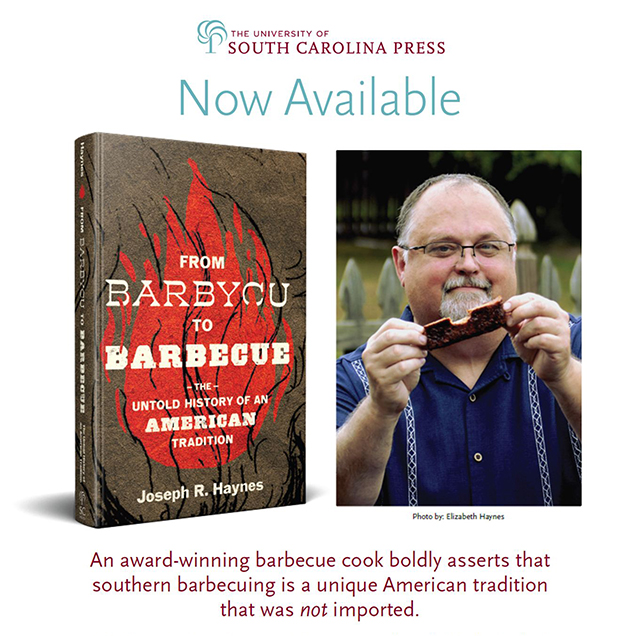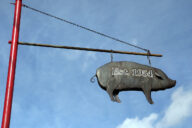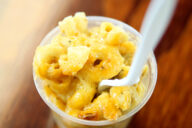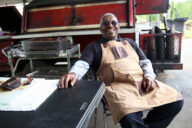Article by Joseph R. Haynes
Illustration by Walt Taylor
Emporia, Virginia is the home of a delicious stew named chicken muddle. It’s a thick stew that’s traditionally slow-cooked outside in large, iron pots for barbecues and community events. In addition to the chicken, ingredients can include smoked pork, tomatoes, potatoes, butter beans, corn, and onions all seasoned with various herbs and spices. Muddle, you may have noticed, is similar to one of Virginia’s other outdoor-festival stews, Brunswick Stew. Nevertheless, there are some differences between the two that boil down (pun intended) to two significant characteristics.
Both muddle and Brunswick Stew require long cooking times and constant stirring, which produces a stew where its ingredients almost completely melt into a delicious, hearty dish. Unlike Brunswick Stew (I mean real Brunswick Stew, not the chicken and vegetable soup served by too many restaurants) that’s traditionally seasoned only with butter, salt, black pepper, and red pepper, muddle is often seasoned with several other secret herbs and spices known only to the cook. Brunswick Stew is eaten with a spoon unless it’s eaten cold. Muddle, on the other hand, is much thicker and can always be eaten with a fork. In fact, while you can make 20 gallons of Brunswick Stew in a 20-gallon pot, you can’t make that much muddle in one because it has to cook down so much to reach the proper thickness. Some speed up the thickening process by adding crushed crackers as a thickener.
This history of muddle is, well, muddled. Local legend in Emporia says that muddle was first cooked by Native Americans who lived in the region around Brunswick County, Virginia, who served it to the visiting Governor Spotswood in 1716. However, there are strong indications that the stew was brought to this part of the world by immigrants from Great Britain and started out as a fish stew.
The basic recipe for fish muddle can be traced back to eighteenth-century British cookbooks. Recipes in those books for fish stews and chowders bear a remarkable resemblance to muddle. Similar to how fish muddle is made, old British recipes call for frying smoked pork in a large pot to render the fat before adding onions, fish, and more pork in layers until the pot is almost full. The ingredients are covered with water, seasoned with salt and pepper, and allowed to slowly cook until the fish, pork, and vegetables are done. Some added crushed crackers as a thickener and milk or cream for richness. There is also a similar recipe called “Chowder, a Sea Dish” in Mary Randolph’s (a relative of Thomas Jefferson) The Virginia Housewife published in 1824 that calls for the additional ingredient of white wine. If I were a betting man (I bet you I’m not), I’d bet the white wine was added by James Hemings, Jefferson’s enslaved cook who received his culinary education in France.
People in southeast Virginia and other places along the eastern seaboard have been cooking muddle for centuries. Sometimes it’s called “mull,” as it is in Georgia, and “pine bark stew” in North Carolina. It’s also been popular up North. As late as the 1890s, people in Connecticut and Massachusetts cooked muddle using pretty much the same recipes as people in the South. Regardless, the recipes in old British cookbooks for fish stew most likely inspired the American version of fish muddle.
———————————————————————————————————–
The wait is almost over! Preorder author Joseph R. Haynes’s newest book,
From Barbycu to Barbecue: The Untold History of an American Tradition
now at the link below and at other better online book sellers.
www.amazon.com/Barbycu-Barbecue-History-American-Tradition
————————————————————————————————————
The origins of the name muddle, which refers to the stew and the events that feature it, is as muddled as the history of the stew itself. Accounts written during the last half of the eighteenth century tell of people who lived along the Tweed River, which sits on the border of England and Scotland, who often hosted events they referred to as “a kettle of fish.” At those events, fish caught in the river were stewed in large iron pots before being served to all who attended.
The significance of the name “kettle of fish” lies in the fact that English dictionaries from those times defined the phrase as “a muddle.” For centuries, “a fine kettle of fish” has been used to refer to tough situations, often of our own making. It was another way of saying, “You muddled it up.” Therefore, it seems quite plausible that “kettle of fish” transitioned to “fish muddle.” Adding to that plausible explanation is the fact that those same Europeans referred to the act of stirring up mud while catching bottom-dwelling fish “muddling.” Fish muddle in Virginia and North Carolina is often made with rockfish (striped bass). Eighteenth-century Europeans often made their “kettle of fish” with sea-gudeons, which are bottom dwelling fish they nicknamed “rockfish.”
At some point, Virginians started making muddle with squirrel meat, which makes sense because squirrels were often destructive pests during frontier times. Not only could farmers rid themselves of a meddlesome varmint, they could also throw a party after the hunt. As towns and cities emerged, people found it more convenient to use chicken in place of squirrel. After tomatoes, potatoes, corn, and beans became a part of the recipe, the chicken muddle we know today was born. The basic recipe is European. The corn and tomatoes are Native American. The slow cooking and artistic blending of spices and herbs are hallmarks of African American cookery. That makes chicken muddle a true American original. And, that’s the slightly unmuddled history of Virginia’s chicken muddle.
JOSEPH R. HAYNES is an award-winning barbecue cook, a Kansas City Barbeque Society Master Certified Barbeque Judge and the author of two books: Virginia Barbecue: A History and Brunswick Stew: A Virginia Tradition. He also authored the Virginia Barbecue Proclamation that was unanimously passed by the Virginia State Legislature in 2016.
He can be reached for inquiries for speaking engagements, consulting, questions or comments through his Facebook page at https://www.facebook.com/VirginiaBarbecue101/








No Comments